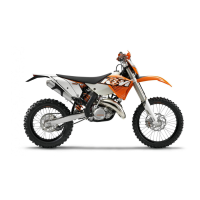
Do you have a question about the KTM 300 XC?W USA 2010 and is the answer not in the manual?
| Displacement | 293.2 cc |
|---|---|
| Bore x Stroke | 72 x 72 mm |
| Transmission | 6-speed |
| Fuel System | Keihin PWK 36 S AG |
| Ignition | Kokusan |
| Final Drive | Chain |
| Front Brake | Disc brake |
| Rear Brake | Disc brake |
| Starter | Kick |
| Front Tire | 80/100-21 |
| Engine Type | Single cylinder, 2-stroke |
| Fuel Capacity | 9.5 L |
| Front Suspension | WP USD 48 mm |
| Rear Suspension | WP monoshock |
| Wheelbase | 1475 ± 10 mm (58.1 ± 0.4 in) |
Field to record chassis, engine, and key numbers for vehicle identification.
Explanation of icons and symbols used throughout the owner's manual.
Explanation of typographical conventions and formatting applied in the text.
Defines the intended use and operational scope for EXC/SIX DAYS and XC-W/XC models.
Stresses regular maintenance for warranty and vehicle longevity.
Guidelines for using approved parts and following workshop procedures.
Safety measures and considerations when transporting the vehicle.
Encourages responsible riding practices for environmental protection.
Defines levels of danger, warning, and note for hazard identification.
Emphasizes reading the manual for safe operation and maintenance.
Identifies key components visible from the front-left perspective.
Identifies key components visible from the rear-right perspective.
Details the location of the vehicle's unique chassis identification number.
Shows the location and purpose of the vehicle's type label.
Explains where to find the key number for security.
Details the location of the engine's serial number.
Shows where to find the part number for the front fork assembly.
Details the location of the shock absorber's part number.
Clutch, brake, throttle, and main switches on handlebars.
Operation of the instrument panel, including speedometer and trip master.
Explains operation of fuel tap, choke, and electric starter button.
Details on shift lever, kickstarter, and foot brake lever operation.
Instructions for locking and unlocking the steering.
Essential safety and operational tips for new riders and first use.
Recommended steps for properly running in the engine.
Guidance on adjusting the vehicle for varied terrains and weather.
Specific steps for optimal performance and protection in dry sand.
Specific steps for optimal performance and protection in wet sand.
Specific steps for riding on wet and muddy terrain.
Adjustments for riding in hot weather and at low speeds.
Adjustments for riding in cold weather and snowy conditions.
Essential safety and functional checks before operating the vehicle.
Step-by-step guide for safely starting the motorcycle's engine.
Guidance on proper gear shifting and riding practices.
Instructions on effective and safe braking methods.
Steps for safely stopping and parking the motorcycle.
Safety precautions and best practices for refueling.
Tasks recommended for performance by an authorized KTM workshop.
Optional maintenance services that can be requested from a workshop.
Routine checks and maintenance tasks the rider can perform.
Correct procedures for safely lifting the motorcycle for maintenance.
Adjusting suspension components based on rider's body weight.
Adjusting low/high-speed compression and rebound damping on the shock absorber.
Adjusting the fork's compression and rebound damping settings.
Covers cleaning, tension checking, wear inspection, and guide adjustment.
Includes checking discs, linings, fluid levels, and lever free travel.
Steps for removing and reinstalling front and rear wheels.
Procedures for checking antifreeze, coolant levels, draining, and refilling.
Covers air filter cleaning, box lid R&I, and idle speed adjustment.
Includes checking, draining, refilling, and adding gear oil.
Diagnosing and resolving problems with engine cranking and starting.
Troubleshooting issues related to idle speed, acceleration, and power delivery.
Diagnosing causes for engine stalling, popping into carburetor, or overheating.
Guidelines for washing, drying, and protecting the motorcycle safely.
Steps to prepare the motorcycle for extended storage, including checks.
Procedures for putting the motorcycle back into service after storage.
Technical details for engine variants including displacement, bore, stroke.
Specified torque values for engine component fasteners.
Jetting and settings for various carburetor models across different bikes.
Jetting settings based on altitude and ambient temperature.
Frame, suspension, dimensions, weight, and load limits.
Information on headlights, indicators, and other lighting components.
Approved tire sizes and fuel tank capacity details.
Details on fork type, damping, spring rate, and oil for various models.
Details on shock absorber type, damping, spring rate, and sag for various models.
Specified torque values for various chassis component fasteners.
Electrical schematic for specific EXC and SIX DAYS EU models.
Electrical schematic for specific EXC AUS/EU models.
Electrical schematic for specific XC USA and XC-W USA models.
Electrical schematic for specific XC-W and XC models.
Recommended types and standards for brake fluid.
Recommended coolant types, mixture ratios, and protection levels.
Recommended engine oil types and standards (JASO, SAE).
Recommended fork oil types and standards.
Recommended hydraulic fluid types and standards.
Recommended shock absorber oil types and standards.
Recommended gasoline and 2-stroke oil mixing ratios.
Recommended cleaner for the air filter element.
Recommended cleaner for the drive chain.
Recommended cleaners for metal, rubber, plastic, and electrical contacts.
Recommended grease, chain spray, and filter oil.
Recommended multi-purpose oil spray for lubrication.
Explanation of the JASO T903 MA standard for motorcycle oils.
Explanation of SAE ratings for oil viscosity.
Explanation of the JASO FC standard for 2-stroke engine oils.











